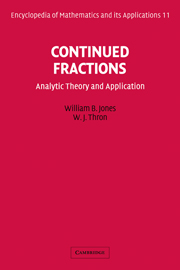Book contents
- Frontmatter
- Contents
- Editor's Statement
- Section Editor's Foreword
- Introduction by Peter Henrici
- Preface
- Symbols
- Continued Fractions
- Chapter 1 Introduction
- Chapter 2 Elementary Properties of Continued Fractions
- Chapter 3 Periodic Continued Fractions
- Chapter 4 Convergence of Continued Fractions
- Chapter 5 Methods for Representing Analytic Functions by Continued Fractions
- Chapter 6 Representations of Analytic Functions by Continued Fractions
- Chapter 7 Types of Corresponding Continued Fractions and Related Algorithms
- Chapter 8 Truncation-Error Analysis
- Chapter 9 Asymptotic Expansions and Moment Problems
- Chapter 10 Numerical Stability in Evaluating Continued Fractions
- Chapter 11 Application of Continued Fractions to Birth-Death Processes
- Chapter 12 Miscellaneous Results
- Appendix A Classification of Special Types of Continued Fractions
- Appendix B Additional Results on Minimal Solutions of Three-Term Recurrence Relations
- Bibliography
- Author Index
- Subject Index
Introduction by Peter Henrici
Published online by Cambridge University Press: 04 August 2010
- Frontmatter
- Contents
- Editor's Statement
- Section Editor's Foreword
- Introduction by Peter Henrici
- Preface
- Symbols
- Continued Fractions
- Chapter 1 Introduction
- Chapter 2 Elementary Properties of Continued Fractions
- Chapter 3 Periodic Continued Fractions
- Chapter 4 Convergence of Continued Fractions
- Chapter 5 Methods for Representing Analytic Functions by Continued Fractions
- Chapter 6 Representations of Analytic Functions by Continued Fractions
- Chapter 7 Types of Corresponding Continued Fractions and Related Algorithms
- Chapter 8 Truncation-Error Analysis
- Chapter 9 Asymptotic Expansions and Moment Problems
- Chapter 10 Numerical Stability in Evaluating Continued Fractions
- Chapter 11 Application of Continued Fractions to Birth-Death Processes
- Chapter 12 Miscellaneous Results
- Appendix A Classification of Special Types of Continued Fractions
- Appendix B Additional Results on Minimal Solutions of Three-Term Recurrence Relations
- Bibliography
- Author Index
- Subject Index
Summary
Mathematics derives much of its vitality from the fact that it has several faces, each face having its own sharply distinguished features. One face, which might be called the dialectic face of mathematics, is the face of a scholar, or even of a philosopher. It is the face which tells us whether theorems are true or false, and whether mathematical objects with specified properties do or do not exist. Dialectic mathematics is an intellectual game, played according to rules about which there is a high degree of consensus, and where progress can be measured sharply in terms of the generality of a result that has been achieved.
There is another, entirely different face of mathematics, which I like to call its algorithmic face. This is the face of an engineer. The algorithmic mathematician tells us how to construct the beautiful things of whose existence we are assured by the dialectic mathematician. The rules of the game of algorithmic mathematics, and in particular the significance attached to results in algorithmic mathematics, depend on the equipment that is available to carry out the required constructions.
Dialectic mathematics has experienced a continuous growth at least since the time of C. F. Gauss. Algorithmic mathematics, on the other hand, has stagnated from Euler's time until very recently, because no really new computing equipment came into existence; even the manually operated desk calculator did not significantly increase the speed of computation. It has been brought to light by H. H. Goldstine that Gauss in essence invented the fast-Fourier-transform algorithm.
- Type
- Chapter
- Information
- Continued FractionsAnalytic Theory and Applications, pp. xix - xxiiPublisher: Cambridge University PressPrint publication year: 1984



